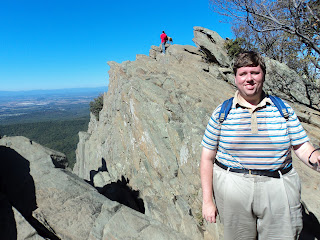Hike Location: Blue Ridge Parkway, Humpback Rocks Visitor Center
Geographic Location: south of Waynesboro, VA (37.97250, -78.89923)
Length: 4.8 miles
Geographic Location: south of Waynesboro, VA (37.97250, -78.89923)
Length: 4.8 miles
Difficulty: 8/10 (Moderate/Difficult)
Date Hiked: October 2010
Overview: A stiff climb to Humpback Rocks followed by an easy downhill glide on the Appalachian Trail.
Date Hiked: October 2010
Overview: A stiff climb to Humpback Rocks followed by an easy downhill glide on the Appalachian Trail.
Area Information: http://www.nps.gov/blri/planyourvisit/humpback-rocks-mp-5-8.htm
Hike Route Map: https://www.mappedometer.com/?maproute=723454
Photo Highlight:
Hike Route Map: https://www.mappedometer.com/?maproute=723454
Photo Highlight:
Directions to the trailhead: The Humpback Rocks Visitor Center is located at milepost 5.8 on the Blue Ridge Parkway. Milepost 5.8 is (obviously) 5.8 miles south of I-64 and 21.6 miles north of SR 56.
The hike: If you are starting south on the Blue Ridge Parkway from milepost 0 in Rockfish Gap, the first major point of interest you come to is the Humpback Rocks Visitor Center and its adjacent Mountain Farm. Some people do not see the need to stop so quickly, but for those willing to stop and spend a few hours, interesting history and great views await.
Mountain Farm is a recreated 1890’s Appalachian farm. Most of the buildings in the farm have been moved from other points along the Parkway. By touring the farm and the adjacent Visitor Center, you can get a good idea of what life was like in this area over a century ago.
The farm area will be crowded on a nice weather day, but only a few people will hike to Humpback Rocks, and even fewer will hike the entire Humpback Rocks Loop described here. Combining the developed Mountain Farm Trail through the farm and the rugged Humpback Rocks Loop yields an interesting hike replete with history, scenic views, and great forest hiking.
 |
| Entering Mountain Farm |
 |
| Barn at Mountain Farm |
More buildings sit beyond the homestead, including a spring house, a barn with large gaps between the logs, and some pigpens. Past the last building, continue on the gravel trail to pass through “kissin’ gate” and leave the farm area. A short ascent will lead you through a meadow to the Parkway, where you should cross the road to reach the Humpback Gap Parking Area and the beginning of the Humpback Rocks Loop.
 |
| Humpback Rocks trailhead |
0.5 miles from the Visitor Center, an opening in the trees to the right gives a nice view across the meadow and toward the Shenandoah Valley to the west. This meadow is called Coiner’s Deadenin’. Deadenin’ was a method of clearing land to prepare it for farming. Trees would be stripped of their leaves, and crops would be planted between the leafless skeletons. Unable to perform photosynthesis, the trees would die, and the trunks would be chopped down at a later, more convenient date to fully clear the land.
 |
| Climbing through Coiner's Deadenin' |
 |
| Old trail to Humpback Rocks exits left |
At 1.2 miles, you reach the crest of the flat-topped ridge and a trail intersection. Our hike will eventually use the trail to the right to reach the Appalachian Trail (AT), but for now angle left on the spur trail to Humpback Rocks. A wooden post bearing the word “Rocks” and an arrow marks the way. A few hundred feet of rather flat hiking will lead you to the base of the rocks.
 |
| Spur trail to Humpback Rocks |
 |
| View from Humpback Rocks |
 |
| The Mathprofhiker at Humpback Rocks |
From the rocks, retrace your steps to the trail intersection. Most people go back down the way they came up. They must not know that only 40 more feet of climbing will yield some time on the AT plus a more gradual and less crowded route back to the parking lot. You have already climbed over 700 feet, so you might as well reap the full benefits of this investment by continuing straight at the trail intersection, heading for the AT.
A little more moderate to steep climbing over another 0.2 miles will lead you to an intersection with the AT 1.5 miles into the hike. Turn left to begin heading northbound on the AT, following the famous white rectangular paint blazes. As painful as the climb up was, this part of the hike is equally delightful. Based on the crowded parking lot, I was surprised when I did not meet another single person on the AT. I also found it hard to believe that a descent this gradual could get me all of the way back down, but it did and does.
 |
| A switchback on the AT |
 |
| Hiking on Howardsville Turnpike |
At 4.1 miles, you reach a signed trail junction. The AT heads right to continue its northward journey to Maine, but our hike continues straight on the Howardsville Turnpike to head back to the parking area. The white blazes of the AT are replaced by the light blue blazes of the Humpback Rocks Loop. At 4.5 miles, you close the loop as you reach the Humpback Rocks parking lot. Retrace your steps across the Blue Ridge Parkway and along the gravel Mountain Farm Trail to complete the hike.
Cool. I was at this place too. I went with my brother last winter in Jan.
ReplyDelete